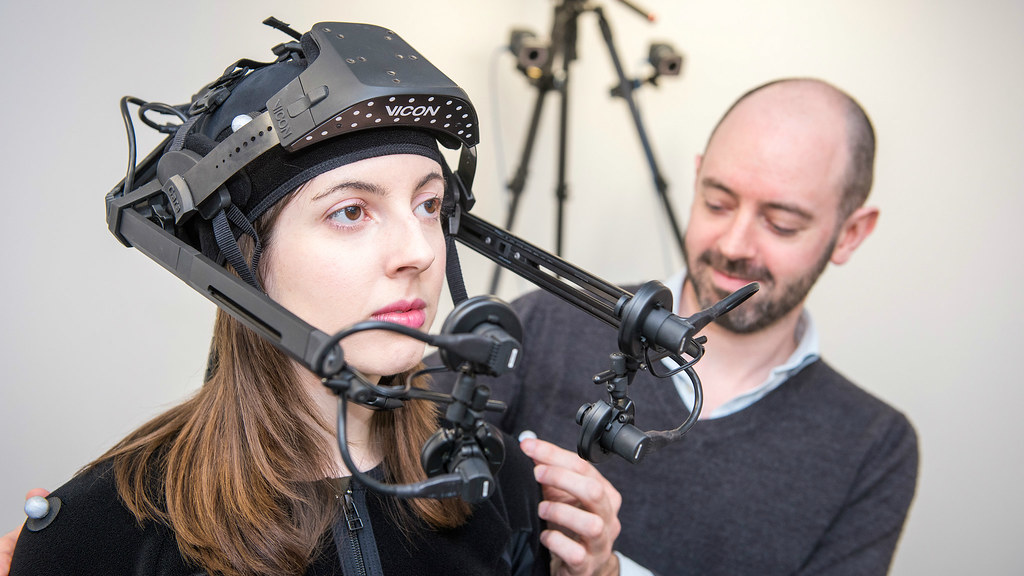The motion capture techniques currently used by the film industry to animate non-human characters, such as Gollum in The Lord of The Rings films, require actors to wear a special spotted motion capture suit. The movement of the spots on the close-fitting suit are tracked by a series of high resolution cameras as the performer moves, transferring the movement of the actor onto the animation.
By contrast, the studio for the new £5 million Centre for the Analysis of Motion, Entertainment Research & Applications (CAMERA) based within our Department of Computer Science, will feature state-of-the-art imaging technology which the research team aims to use to capture detailed motion information without using tracking suits.
The Centre for the Analysis of Motion, Entertainment Research & Applications (CAMERA) is a £5 million EPSRC-funded research centre based at the University of Bath. CAMERA will create advanced motion tracking technologies for use in the entertainment industry, to enhance athlete performance, and to help develop assistive technologies. More info: http://www.bath.ac.uk/research/news/2015/07/10/centre-analysis-motion-entertainment-research-applications
The Centre was announced this week as part of a £23 million investment in digital economy research from last week's Chancellor’s Budget. Funded by the Engineering & Physical Sciences Research Council (EPSRC) and the Arts & Humanities Research Council (AHRC), CAMERA will focus on three areas of research: entertainment; enhancing athlete performance; and helping develop assistive technologies.
Using motion capture
Motion capture technology was first developed by the biomechanics field to help train elite athletes by studying their gait and movement and was later applied by the entertainment industry to make computer animation in films and games more realistic.
Dr Darren Cosker, Royal Society Industry Fellow from the University’s Department of Computer Science, is leading the project in collaboration with the University’s Department for Health.
He commented: “This is a really exciting project that takes new advances in this technology back to its roots in biomechanics and will use it in a range of new areas from training elite athletes to rehabilitating injured service personnel.
“We’re aiming to develop this technology further – using advances in computer vision and graphics - so that obtrusive motion capture suits required for accurate human body motion analysis will no longer be required. This will mean that actors can be filmed in costume, athletes’ performance can be assessed in a normal training session, and amputee patients can have clinical physiotherapy assessments in their own homes.”
The research team will be working with current and former members of the armed forces who have undergone amputations and/or are suffering osteoarthritis, analysing their movement with prosthetic limbs and using the information to design better prosthetics and correct adverse movement patterns.
Dr James Bilzon, Senior Lecturer in Exercise Physiology and Head of our Department for Heath, added: “This is a very exciting opportunity to build on our existing research strengths in human biomechanics and exercise-based rehabilitation.
“Working with colleagues in Computer Science and other external industries, we will develop the evidence-base for new and innovative solutions to complex societal challenges.
“We have been working in partnership with athletes and sports governing bodies, as well as patients and medical practitioners in the National Health Service and Ministry of Defence, for many years. We all recognise that the next significant step-change in the development of our work will be realised by the strategic integration of multidisciplinary approaches to these issues. CAMERA therefore presents a significant long-term opportunity for us, and our non-academic partners, to reach new heights.”
In partnership
The team is collaborating with top visual effects companies including The Imaginarium and The Foundry, and will also work in partnership with BMT Defence Services, British Skeleton, The Ministry of Defence, Bath & North East Somerset Council, the West of England Local Enterprise Partnership and the Bath Innovation Centre to develop the technology alongside a wide range of users, from elite athletes to injured servicemen.
The new facility will also be used by the Centre for Digital Entertainment (CDE), a doctoral training centre based at our University of Bath in partnership with Bournemouth University.
In addition to research projects planned, the Centre will be the first motion capture studio facility in the South West for commercial use.
The Imaginarium Studios, a top visual effects company co-founded by actor and producer Andy Serkis, who played Gollum in The Hobbit, is one of the industrial partners on the project.
CEO Tony Orsten commented: "The potentials for future motion capture technologies within the film industry, where we could see a real step change in the ways in which visual effects are delivered, are particularly exciting. At The Imaginarium we're looking forward to working with researchers from the University of Bath on this innovative and exciting project."
Other researchers at the University collaborating on this project include: Professor Eamonn O'Neill (Co-Director), Dr Neill Campbell, Professor Peter Hall, Dr Yongliang Yang and Professor Phil Willis from our Department of Computer Science, and Dr Aki Salo from our Department for Health.

